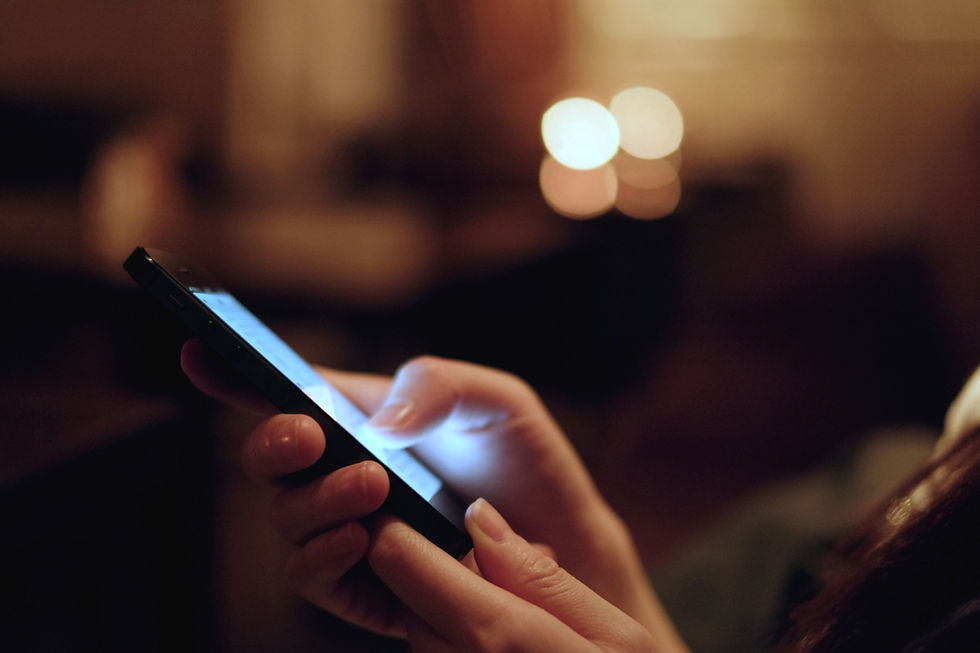Stuck Scrolling?
- Taylor Marie Santiago
- Aug 5, 2022
- 3 min read
Updated: Aug 11, 2022
College students are falling victim to sedentary lifestyles.

The typical student uses the internet for more than six hours daily. Continuously scrolling through social media apps results in more significant health issues in the long run. You could develop poor posture, headaches, or even vision issues. Due to the prevalence of cellphones, video games, and television, students spend more time sitting than exercising. Heidi Zwart explains in the “Effect of Social Media on College Students,” the benefits and disadvantages of social media:
Positive benefits: connection to others, school pride, career development, and moderation
Disadvantages: poor relational health, emotional health, physical, and financial health.
When you think about going to college you probably think that this is the time to really start maturing into a responsible and independent adult. There will always be times when we are overwhelmed by what’s on our plates, especially when it comes to huge life changes, we often tend to procrastinate and feel lazy. It’s time to be aware of how much time you give to a sedentary lifestyle.

A research article, “Stand Up, Students! Decisional Cues Reduce Sedentary Behavior in University Students,” discusses that sedentary behavior (SB) is common among university students and is linked to a number of detrimental health effects. Sedentary behavior (SB) is defined as awake behavior with an energy expenditure of 1.5 Metabolic Equivalents while sitting, lying down, or reclined (METs). Obesity, cancer, type 2 diabetes, cardiovascular disease, and total mortality, as well as issues with social interaction and academic performance, have all been linked to SB. Deficits in social, behavioral, and academic performance may be the result of sedentary screen-based activities like watching TV and playing video games, which take up time that could be spent interacting with peers or studying for exams. College students are particularly vulnerable to SB. As people with a university degree are expected to be sedentary for roughly 7 hours per day for the following 10 years, the SB persists after graduation. (Minch, 2019).
You’re most likely stuck on your phone scrolling through social media like Facebook or Instagram, watching something on TikTok or Youtube. When you’re on campus, at home, waiting in line, on the toilet, even when you’re out in public and start to feel the awkwardness creeping in, you're itching to grab a hold of your phone and begin to scroll through social media.
Reports have shown:
American university students spend 4.2 h per day sitting down on average. In a study that monitored the sitting time of adults in 20 countries, the daily average was 5.8 h, and adults in the United States, Canada, and the United Kingdom spent 9–11 h per day sitting down, comprising 55–70% of their waking hours. (Lee, RN, Ph.D., 2018).
A questionnaire taken at Prince Sattam bin Abdul Aziz University showed:
97% of the students used social media applications.
Only 1% of them used social media for academic purposes.
35% of them used these platforms to chat with others
43% of them browsed these sites to pass time
57% of them were addicted to social media
52% of them reported that social media use had affected their learning activities
66% of them felt more drawn toward social media than toward academic activities
74% of them spent their free time on social media platforms
68% of them attributed their delayed bedtime to social media use
59% of them reported that social media had affected their social interactions. (Kolhar, 2021)
On NIH, National Library of Medicine, "How Sedentary Are University Students? A Systematic Review and Meta-Analysis" reports:
Reported screen time: 61%
Total sedentary time: 38%
Self-reported data indicated that university students spend 7.29 hours per day being sedentary. (Castro, 2020)

People must show motivational preparedness and actively take steps to reduce sedentary behaviors in order to reduce sedentary habits in college student populations. Head over to our Physical Activity press page to learn more on how to combat being sedentary in college with physical activity.
Resources
Castro , O., Bennie, J., Vergeer, I., Bosselut, G., & Stuart J H. (2020, April 21). How
sedentary are university students? A systematic review and meta-analysis. Prevention science : the official journal of the Society for Prevention Research. Retrieved from https://pubmed.ncbi.nlm.nih.gov/31975312/
Kolhar, M., Kazi, R. N. A., & Alameen, A. (2021, January 21). Effect of social media use
on learning, social interactions, and sleep duration among university students. NIH National Library of Medicine. Retrieved from https://www.ncbi.nlm.nih.gov/pmc/articles/PMC8071811/
Lee, E., & Kim, Y. (2018, May 24). Effect of university students’ sedentary behavior
on stress, anxiety, and depression. Wiley Online Library. Retrieved from https://onlinelibrary.wiley.com/doi/full/10.1111/ppc.12296
Mnich, C., Bachert, P., Kunkel, J., Wäsche, H., Neumann, R., & Nigg, C. R. (2019,
August 20). Stand up, students! decisional cues reduce sedentary behavior in university students. Frontiers. Retrieved from https://www.frontiersin.org/articles/10.3389/fpubh.2019.00230/full
Zwart, H. (2022). Effect of social media on college students. BetterYou. Retrieved



Comments